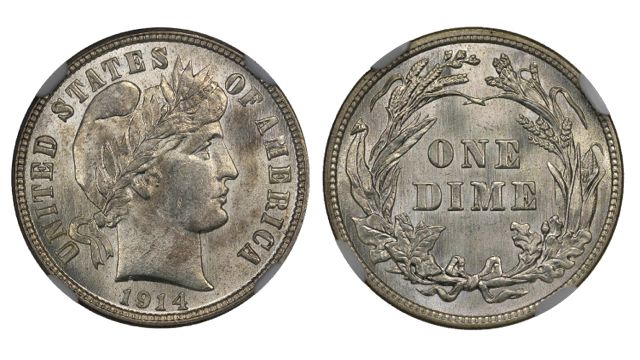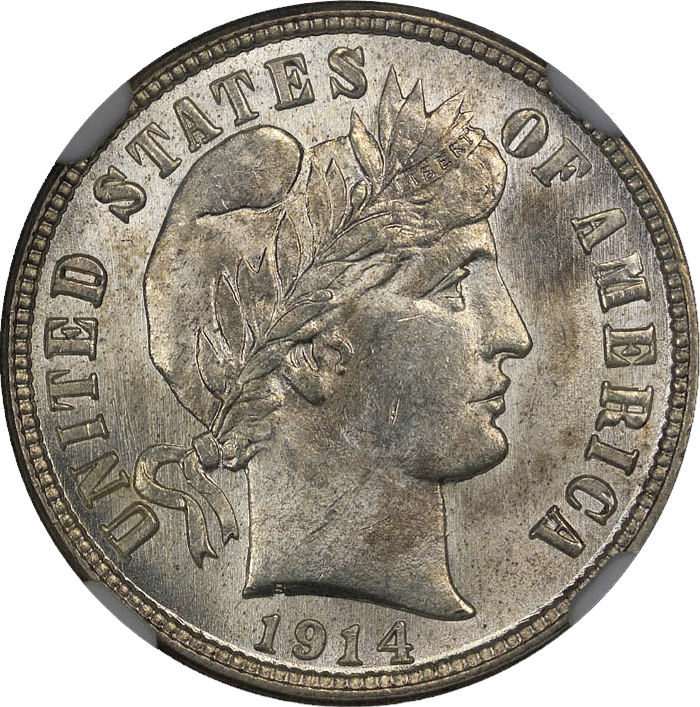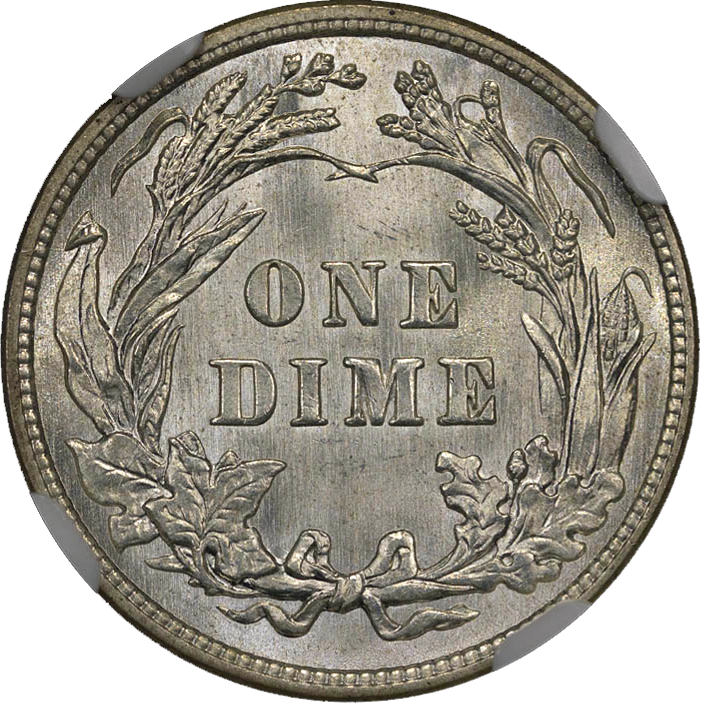
Barber Dimes, designed by the eponymous Charles E Barber, were produced from 1892 through 1916. Here is the history, collectors notes, key dates, and also the story of the 1894-S which easily commands $1.5 million.
The History of the Barber Dime
by Keith Scott
In 1887, Mint Director James P. Kimball noted in his annual report the “inferiority of our coinage” compared to other advanced nations and that in his opinion, the coinage of the U.S. was out of date and should be changed. At the request of Kimball, Senator Justin S. Morill introduced a bill authorizing the Treasury Department to redesign coins without first obtaining the permission of Congress, as long as the current design had been in use for at least 25 years. The bill passed on September 26, 1890 and the dime, quarter and half dollar were targeted for change. The decision of who should redesign the coins eventually fell to his successor, Edward O. Leech.
Ironically, new designs were submitted by Mint engravers throughout the early 1880’s but the only change that occurred was a new nickel designed by Charles E. Barber in 1883. In 1891, when there was discussion of a public competition for new designs. Barber reported to Mint director Kimball that there was no one in the country capable in assisting him in preparing original designs. Augustus Saint-Gaudens confided to Kimball there were only four men in the world competent do to such a redesign: three were in France and he was the fourth.
It did not matter. Kimball insisted that rather than going abroad to find the best design talent available, it would be possible to find able designers in America. Against the advice of Barber, the Treasury Department organized a competition to produce new designs. A panel of 10 of the leading artist and sculptors of the day were commissioned to judge which would be the best designs for new coinage. The panel met and instead of discussing the competition, they instead rejected the terms of the competition as proposed by Mint officials on the ground that the preparation time was too short and the compensation woeful. The Mint director rejected the panels’ suggestions and threw the competition out to the public. The results were disastrous. Of the more than 300 drawings submitted, only two received an honorable mention by a smaller judging panel. It is interesting to note that two of the judges were Barber and Saint-Gaudens.

When Leech took over as Mint director, he was well aware of the problems his predecessor had experienced. In order to get new designs into production and avoid another disaster of a competition, he simply directed Barber to draw up new designs.
This is what Barber had wanted all along has he felt as Chief Engraver, he, and he alone was responsible for coin design. The result was not much in the way of originality. That would have to wait for more than another 25 years. What Barber did was to modify the large head used on the Morgan dollar by adding a Liberty cap and cropping Liberty’s hair shorter in back. He then placed his initial B on the truncation of the neck. This was the design used not only on the dime, but the new quarter and the new half dollar as well.
The reverse did not go through much of an overhaul either as it uses almost the exact same reverse of its predecessor, the Seated Liberty Dime. While many do not credit Barber with much artistic ability, what he lacked in design capabilities he made up for in knowledge in regards to designing a coin that would withstand a modern high-speed coin press. On January 2, 1892, the first of over half a billion Barber dimes were struck.

Collectibility General
The Barber dime series consists of 74 regular issues, plus the super-rare 1894-S. While half a billion dimes for an entire series pales in comparison to today’s coin production, it was big numbers back in the 1800’s.
With a low relief, Barber dimes faired well and although there are a few semi-key issues (not including 1894-S), an entire set in circulated condition can be assembled for under $1500.00 in G4 or so condition. As is common with many series of this time period, Philadelphia was the main producer of coinage. The San Francisco and New Orleans mint typically produced far few examples in almost all years of production making earlier years more difficult to obtain. Denver did not begin producing Barber dimes until 1906.
Key/Semi Key Dates
While most Barber Dimes are obtainable, one of the rarest of all coins came from this series. The 1894-S dime had a total mintage of 24 and only 10 can now be accounted for which presents one of the great numismatic mysteries of the time. Allegedly, 24 pieces were struck at the order of San Francisco Mint Superintendent J. Daggett. Of the ten known, all were struck from the same set of dies.
The best known story is that Daggett gave three to his daughter Hallie and told her to keep them until she was as old as he was, when they would be worth a lot of money. On her way home from the mint, her newfound riches got the best of her and she spent one of the dimes on a dish of ice cream. Today that coin is known as the ice cream specimen. Although there is no proof it was the one that a young Hallie spent, one of the known specimens is heavily circulated. It has been graded as a G4 while all other coins are MS/PR60+ condition. Robert Freidberg bought this coin over the counter for $2.40 (24 times face value) at Gimbels Department Store, NY, in 1957. If it is the “Ice Cream Specimen”, it certainly got around.
Why did the mint only produce 24 dimes that year? There are two stories. The first is that the coins were struck to provide a balance of forty cents needed to close a bullion account at the San Francisco Mint by June 30, 1894 – the end of the fiscal year. Since any even numbered (2, 4, 6, 8) dollar amount ending in forty cents was acceptable, the employees were said to have struck 24 pieces, or $2.40. The expectation was that the Mint would receive orders for more dimes before the end of the calendar year. December 31 passed without a request for further production. According to the story, two or three pieces were obtained by Mint employees “just to have a new dime,” and when they realized the coins were now rare, they sold them to collectors for $25 or more apiece. The remaining 1894-S dimes went into a bag with other dimes and into circulation.
The more widely accept story is that the dimes were minted as a special request for some visiting bankers. According to an account from California dealer Earl Parker, who bought the two remaining dimes that Hallie Daggett had, Hallie told Parker that her father minted the coins and presented 3 to each of the 7 visitors and gave the remaining three to her which has previously mentioned, she spent one dime on ice cream.
Most experts believe the “visiting bankers” theory as the likely reason. Of the known high grade coins, they all seem to be proof strikes. It is unlikely that such care would have taken place to produce a few dimes to even out the books but it quite likely for coins made for presentation.
Putting the 1894-S aside, most, if not all dimes are readily available in low grades. Collecting the series in higher grades is still achievable but certainly more challenging. Recall that this coin was heavily circulated. Assembling a collecting of all MS65 or better, while no doubt out of the financial reach of most collectors, is possible, as there is at least 1 coin graded in MS65 by PCGS for each mint and year.
For the rest of us, collecting this series in average circulated grades is without a doubt doable. Back during the days of this coin, a dime was real money and as such, this series is heavily circulated. While many dates had mintages in the millions, there are a few dates where the total mintage is around 500,000 thereby making the acquisition of these a little more challenging and painful to the wallet/purse.
For example, the 1895-O had a mintage of 440,000. Obtaining this coin in a grade of G to VG could cost you between $400-$600. It only gets worse from there as an XF-40 will cost you over $2000. The 1901-S had a mintage of 593,022 and is not quite as expensive and can be had for less than $100 in G condition and for around $500 in XF-40 condition. The 1903-S had a mintage of 613,300 and is similar priced on lower grades but is higher priced than the 1901-S in higher grades suggesting the 1903-S did not fair as well in circulation. The second lowest mintage dime was the 1913-S with a mintage of 510,000. While having the second lowest mintage, it is not in the top 10 as far as price and can be had for around $20 in G4 and $35 for VG8.
Earlier coins, even those with mintages over a million pieces, will cost you more than the 1913-S suggesting that earlier dates, even those with high mintages may be tough to acquire.
If the cost of an entire set is too much, a year set could prove to be a much more frugal approach. As mentioned earlier, the Philadelphia mint generally produced the majority of Barber dimes. The only year that a branch-mint exceeded production of Philadelphia was in 1895 when Philadelphia produced only 690,880 pieces while San Francisco produced 1,120,000. With the expectation of a few earlier dates, most Philadelphia examples can be obtained for a few dollars in G4 and for less than $10.00 per coin in F to VF condition.
If you are into collecting Barber type coins, the Barber dime may be just the ticket for the budget conscience collector.
Errors
The Barber dime series consists two major varieties (1893/2-P and 1905-O micro-O).
Proofs
There are 24 coins in the proof Barber dime series, not counting the branch mint proof 1894-S. The mintages range from 425 for the 1914 to 1,245 for the first-year-of-issue 1892. A grand total of 17,353 proof coins were produced for the whole series. While extremely low, the rarest of proofs in MS-65 is the 1908 with 12 pieces certified at PCGS.
Vital Statistics
Summary Key Coin Info:
- Designed by: Charles E. Barber
- Issue dates: 1892-1916
- Composition: 0.900 part silver, 0.100 part copper
- Diameter: 17.9 mm.
- Weight: 38.58 grains (2.5 g)
- Edge: Reeded
- Business strike mintage: 504,317,075
- Proof mintage: 17,353
Keith Scott has been a collector for over 30 years. His website has US coins for sale. He also writes Coin Collecting Articles for fun. Visit his websites for a history of US coins, metal market updates and news about your favorite coins.
Article used by kind of permission of mountainviewcoins.com








